Body mass index cut offs to define thinness in children and adolescents: international survey
- PMID: 17591624
- PMCID: PMC1934447
- DOI: 10.1136/bmj.39238.399444.55
Body mass index cut offs to define thinness in children and adolescents: international survey
Abstract
Objective: To determine cut offs to define thinness in children and adolescents, based on body mass index at age 18 years.
Design: International survey of six large nationally representative cross sectional studies on growth.
Setting: Brazil, Great Britain, Hong Kong, the Netherlands, Singapore, and the United States.
Subjects: 97 876 males and 94 851 females from birth to 25 years.
Main outcome measure: Body mass index (BMI, weight/height(2)).
Results: The World Health Organization defines grade 2 thinness in adults as BMI <17. This same cut off, applied to the six datasets at age 18 years, gave mean BMI close to a z score of -2 and 80% of the median. Thus it matches existing criteria for wasting in children based on weight for height. For each dataset, centile curves were drawn to pass through the cut off of BMI 17 at 18 years. The resulting curves were averaged to provide age and sex specific cut-off points from 2-18 years. Similar cut offs were derived based on BMI 16 and 18.5 at 18 years, together providing definitions of thinness grades 1, 2, and 3 in children and adolescents consistent with the WHO adult definitions.
Conclusions: The proposed cut-off points should help to provide internationally comparable prevalence rates of thinness in children and adolescents.
Conflict of interest statement
Figures
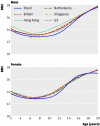
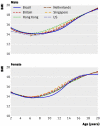
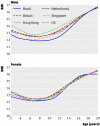
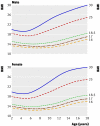
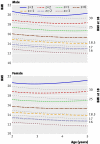
Comment in
-
Body mass index cut offs to define thinness in children and adolescents.BMJ. 2007 Jul 28;335(7612):166-7. doi: 10.1136/bmj.39281.439178.80. BMJ. 2007. PMID: 17656507 Free PMC article.
References
-
- Lobstein T, Baur L, Uauy R. Obesity in children and young people: a crisis in public health. Obes Rev 2004;5(suppl 1):4-85. - PubMed
-
- Pelletier DL. The relationship between child anthropometry and mortality in developing countries: implications for policy, programs and future research. J Nutr 1994;124:2047-81S. - PubMed
-
- Pelletier DL, Frongillo EA. Changes in child survival are strongly associated with changes in malnutrition in developing countries. J Nutr 2003;133:107-19. - PubMed
-
- El-Ghannam AR. The global problems of child malnutrition and mortality in different world regions. J Health Soc Policy 2003;16:1-26. - PubMed
-
- Staton DM, Harding MH. Protecting child health worldwide. Implementation is the biggest challenge slowing efforts to reduce childhood morbidity and mortality in developing countries. Pediatr Ann 2004;33:647-55. - PubMed
Publication types
MeSH terms
Grants and funding
LinkOut - more resources
Full Text Sources
Medical
